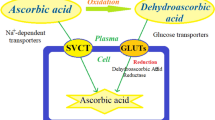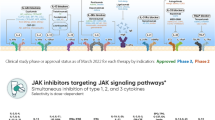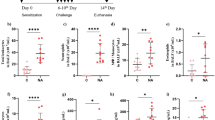Abstract
Object and design
This study is aimed at exploring the effect of Bencycloquidium bromide (BCQB), a novel M1/M3 receptor antagonist, on mucus secretion in a murine model of allergic rhinitis (AR).
Materials and methods
Sprague–Dawley rats were sensitized with ovalbumin to induce AR. After BCQB treatment, nasal symptoms were evaluated. Nasal lavage fluid was used to detect the protein level of cytokines and histamine by the method of enzyme-linked immunosorbent assay. The nasal mucosa of all animals was prepared for western blot, quantitative real-time polymerase chain reaction and histochemical analysis.
Results
BCQB could not only alleviate typical AR symptoms including rhinorrhea, nasal itching and sneezing, but also inhibit the overexpression of mucin 5AC at the level of protein and mRNA. The release of histamine, the mRNA and protein level of IL-6, IL-13 and TNF-α, and the nuclear translocation of NF-κB (p65 and p50) were inhibited by BCQB. In addition, histological studies showed BCQB dramatically inhibited ovalbumin-induced nasal lesions, eosinophil infiltration, aggregation of mast cells, globlet cell hyperplasia and metaplasia.
Conclusions
BCQB attenuates mucus hypersecretion in AR, possibly involving in the NF-κB signaling pathway.









Similar content being viewed by others
References
Won Jung H, Jung JK, Weon Cho C, Kang JS, Park YK. Antiallergic effect of KOB03, a polyherbal medicine, on mast cell-mediated allergic responses in ovalbumin-induced allergic rhinitis mouse and human mast cells. J Ethnopharmacol. 2012;142:684–93.
Bousquet J, Khaltaev N, Cruz AA, Denburg J, Fokkens WJ, Togias A, et al. Allergic Rhinitis and its Impact on Asthma (ARIA) 2008 update (in collaboration with the World Health Organization, GA(2)LEN and AllerGen). Allergy. 2008;63(Suppl 86):8–160.
Wang H, Zhang R, Wu J, Hu H. Knockdown of neurokinin-1 receptor expression by small interfering RNA prevents the development of allergic rhinitis in rats. Inflamm Res. 2013;62:903–10.
Rogers DF. Airway hypersecretion in allergic rhinitis and asthma: new pharmacotherapy. Curr Allergy Asthma Rep. 2003;3:238–48.
Takeuchi K, Yuta A, Sakakura Y. MUC2 mucin gene expression in the nose and maxillary sinus. Am J Otolaryngol. 1995;16:391–5.
Voynow JA, Selby DM, Rose MC. Mucin gene expression (MUC1, MUC2, and MUC5/5AC) in nasal epithelial cells of cystic fibrosis, allergic rhinitis, and normal individuals. Lung. 1998;176:345–54.
Wood SJ, Birchall MA, Carlstedt I, Corfield AP. The expression of MUC5AC in allergic rhinitis. Biochem Soc Trans. 1997;25:504S.
Tai CF, Baraniuk JN. Upper airway neurogenic mechanisms. Curr Opin Allergy Clin Immunol. 2002;2:11–9.
Mullol J, Baraniuk JN, Logun C, Merida M, Hausfeld J, Shelhamer JH, et al. M1 and M3 muscarinic antagonists inhibit human nasal glandular secretion in vitro. J Appl Physiol. 1985;1992(73):2069–73.
Ramnarine SI, Haddad EB, Khawaja AM, Mak JC, Rogers DF. On muscarinic control of neurogenic mucus secretion in ferret trachea. J Physiol. 1996;494(Pt 2):577–86.
Nakaya M, Yuasa T, Usui N. Immunohistochemical localization of subtypes of muscarinic receptors in human inferior turbinate mucosa. Ann Otol Rhinol Laryngol. 2002;111:593–7.
Cortijo J, Mata M, Milara J, Donet E, Gavalda A, Miralpeix M, et al. Aclidinium inhibits cholinergic and tobacco smoke-induced MUC5AC in human airways. Eur Respir J. 2011;37:244–54.
Bos IS, Gosens R, Zuidhof AB, Schaafsma D, Halayko AJ, Meurs H, et al. Inhibition of allergen-induced airway remodelling by tiotropium and budesonide: a comparison. Eur Respir J. 2007;30:653–61.
Bousquet J, Schunemann HJ, Samolinski B, Demoly P, Baena-Cagnani CE, Bachert C, et al. Allergic Rhinitis and its Impact on Asthma (ARIA): achievements in 10 years and future needs. J Allergy Clin Immunol. 2012;130:1049–62.
Bachert C, Vignola AM, Gevaert P, Leynaert B, Van Cauwenberge P, Bousquet J. Allergic rhinitis, rhinosinusitis, and asthma: one airway disease. Immunol Allergy Clin North Am. 2004;24:19–43.
Cruz AA, Popov T, Pawankar R, Annesi-Maesano I, Fokkens W, Kemp J, et al. Common characteristics of upper and lower airways in rhinitis and asthma: aRIA update, in collaboration with GA(2)LEN. Allergy. 2007;62(Suppl 84):1–41.
Zhou W, Ding L, Wang Y, Sun L, Huang Y, Hu L, et al. Solid phase extraction and liquid chromatography-electrospray ionization-mass spectrometry for the determination of bencycloquidium bromide in human plasma. J Chromatogr B Analyt Technol Biomed Life Sci. 2009;877:897–901.
Jiang B, Ruan Z, Lou H, Dong X, Xie Q. Determination of bencycloquidium bromide in dog plasma by liquid chromatography with electrospray ionization tandem mass spectrometry. Biomed Chromatogr. 2010;24:490–6.
Jiang JX, Cao R, Deng WD, Jin F, Dong XW, Zhu Y, et al. Characterization of bencycloquidium bromide, a novel muscarinic M(3) receptor antagonist in guinea pig airways. Eur J Pharmacol. 2011;655:74–82.
Cao R, Dong XW, Jiang JX, Yan XF, He JS, Deng YM, et al. M(3) muscarinic receptor antagonist bencycloquidium bromide attenuates allergic airway inflammation, hyperresponsiveness and remodeling in mice. Eur J Pharmacol. 2011;655:83–90.
Wen WD, Yuan F, Wang JL, Hou YP. Botulinum toxin therapy in the ovalbumin-sensitized rat. NeuroImmunoModulation. 2007;14:78–83.
Zhu Z, Stone HF, Thach TQ, Garcia L, Ruegg CL. A novel botulinum neurotoxin topical gel: treatment of allergic rhinitis in rats and comparative safety profile. Am J Rhinol Allergy. 2012;26:450–4.
Zhao Y, Woo J, Leung P, Chen GG, Wong Y, Liu S, et al. Symptomatic and pathophysiological observations in a modified animal model of allergic rhinitis. Rhinology. 2005;43:47–54.
Wang W, Zheng M. Mucin 5 subtype AC expression and upregulation in the nasal mucosa of allergic rhinitis rats. Otolaryngol Head Neck Surg. 2012;147:1012–9.
Oh HA, Kim HM, Jeong HJ. Beneficial effects of chelidonic acid on a model of allergic rhinitis. Int Immunopharmacol. 2011;11:39–45.
Sun L, Ding L, Wang Y, Zhou W, Yan Z, Sun W, et al. Pharmacokinetics, safety and tolerability of Bencycloquidium bromide, a novel selective muscarinic M1/M3 receptor antagonist, after single and multiple intranasal doses in healthy chinese subjects: an open-label, single-center, first-in-human study. Drugs R D. 2012;12:17–28.
Gwilt CR, Donnelly LE, Rogers DF. The non-neuronal cholinergic system in the airways: an unappreciated regulatory role in pulmonary inflammation? Pharmacol Ther. 2007;115:208–22.
Gosens R, Zaagsma J. Grootte Bromhaar M, Nelemans A, Meurs H. Acetylcholine: a novel regulator of airway smooth muscle remodelling? Eur J Pharmacol. 2004;500:193–201.
Howarth PH, Salagean M, Dokic D. Allergic rhinitis: not purely a histamine-related disease. Allergy. 2000;55(Suppl 64):7–16.
Wang Z, Li P, Li Y, Zhang Q, Qu Q, Qi Y. A preliminary study on the regulation mechanism of p38MAPK on MUC5AC in allergic rhinitis. J Clin Otorhinolaryngol head Neck surg. 2011;25:943–6.
Reinheimer T, Baumgartner D, Hohle KD, Racke K, Wessler I. Acetylcholine via muscarinic receptors inhibits histamine release from human isolated bronchi. Am J Respir Crit Care Med. 1997;156:389–95.
Kaliner M, Orange RP, Austen KF. Immunological release of histamine and slow reacting substance of anaphylaxis from human lung. J Exp Med. 1972;136:556–67.
Wang W, Xu X, Zheng M, Wan L. Lipopolysaccharides induces MUC5AC overproduction in human nasal epithelium. Eur Arch Otorhinolaryngol. 2013;270:541–7.
Kim YM, Won TB, Kim SW, Min YG, Lee CH, Rhee CS. Histamine induces MUC5AC expression via a hCLCA1 pathway. Pharmacology. 2007;80:219–26.
Whittaker L, Niu N, Temann UA, Stoddard A, Flavell RA, Ray A, et al. Interleukin-13 mediates a fundamental pathway for airway epithelial mucus induced by CD4 T cells and interleukin-9. Am J Respir Cell Mol Biol. 2002;27:593–602.
Smirnova MG, Kiselev SL, Birchall JP, Pearson JP. Up-regulation of mucin secretion in HT29-MTX cells by the pro-inflammatory cytokines tumor necrosis factor-alpha and interleukin-6. Eur Cytokine Netw. 2001;12:119–25.
Hayden MS, Ghosh S. Shared principles in NF-kappaB signaling. Cell. 2008;132:344–62.
Fujisawa T, Velichko S, Thai P, Hung LY, Huang F, Wu R. Regulation of airway MUC5AC expression by IL-1beta and IL-17A; the NF-kappaB paradigm. J Immunol. 2009;183:6236–43.
Sheppard KA, Rose DW, Haque ZK, Kurokawa R, McInerney E, Westin S, et al. Transcriptional activation by NF-kappaB requires multiple coactivators. Mol Cell Biol. 1999;19:6367–78.
Acknowledgments
This work was supported by the National Natural Science Foundation of China in 2012 (No.81200008). We are grateful for the valuable help of professor Li-Ke Xiang of the Department of Pathology, Chongqing Medical University with the histology and immunohistochemistry experiments. We also thank Central Laboratory and Clinical Pharmacology Laboratory of the first Affiliated Hospital of Chongqing Medical University for research help.
Author information
Authors and Affiliations
Corresponding author
Additional information
Responsible Editor: Liwu Li.
Rights and permissions
About this article
Cite this article
Long, R., Zhou, Y., Huang, J. et al. Bencycloquidium bromide inhibits nasal hypersecretion in a rat model of allergic rhinitis. Inflamm. Res. 64, 213–223 (2015). https://doi.org/10.1007/s00011-015-0800-6
Received:
Revised:
Accepted:
Published:
Issue Date:
DOI: https://doi.org/10.1007/s00011-015-0800-6




